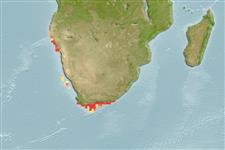>
Eupercaria/misc (Various families in series Eupercaria) >
Sciaenidae (Drums or croakers)
Etymology: Argyrosomus: Greek, argyros = silvered, silver + Greek, soma = body (Ref. 45335); inodorus: Name from the Latin 'inodorus' meaning without smell (first suspected of being a different species because it lacked the strong brassy/metallic smell that is typical of A. japonicus found in South African waters..
Environment: milieu / climate zone / depth range / distribution range
Écologie
marin; saumâtre benthopélagique; océanodrome (Ref. 51243); profondeur 1 - 100 m (Ref. 11025). Subtropical; 17°S - 38°S, 11°E - 29°E
Southeast Atlantic: Namibia southwards around the Cape of Good Hope and northwards at least as far as the Kei River in South Africa.
Length at first maturity / Taille / Poids / Âge
Maturity: Lm 34.4 range ? - ? cm
Max length : 145 cm TL mâle / non sexé; (Ref. 11025); common length : 115 cm TL mâle / non sexé; (Ref. 11025); poids max. publié: 36.3 kg (Ref. 11025)
Description synthétique
Morphologie | Morphométrie
Épines dorsales (Total): 11; Rayons mous dorsaux (Total): 25-29; Épines anales 2; Rayons mous anaux: 7 - 8; Vertèbres: 25. Swim bladder carrot-shaped with 31-42 arborescent appendages, the latero-anterior limb of appendages present throughout length of bladder; drumming muscles present only in males; urinary bladders rudimentary; sagitta elongate with pronounced bulge in posterior third of ventral margin; pectoral fin axillary fold naked; peritoneum unpigmented; anterior part of lateral line slightly curved.
Between the Kei River and Cape Agulhas, this species rarely enters estuaries or the surf zone, but becomes more abundant in the surf zone on the west coast of South Africa. Restricted to a depth of 1-20 m in Namibia, apparently due to anoxic conditions beyond this depth. Highly regarded as a table fish. Marketed mostly fresh, but sometimes frozen (Ref. 11025).
Life cycle and mating behavior
Maturité | Reproduction | Frai | Œufs | Fécondité | Larves
Griffiths, M.H. and P.C. Heemstra, 1995. A contribution to the taxonomy of the marine fish genus Argyrosomus (Perciformes: Sciaenidae), with descriptions of two new species from southern Africa. Ichthyol. Bull., J.L.B. Smith Inst. Ichthyol. No. 65, 40 p. (Ref. 11025)
Statut dans la liste rouge de l'IUCN (Ref. 130435)
Menace pour l'homme
Harmless
Utilisations par l'homme
Pêcheries: commercial; pêche sportive: oui
Plus d'informations
RéférencesAquacultureProfil d'aquacultureSouchesGénétiqueElectrophoresesHéritabilitéPathologiesTraitementNutrientsMass conversion
CollaborateursImagesStamps, Coins Misc.SonsCiguateraVitesseType de nageSurface branchialeOtolithesCerveauxVision
Outils
Articles particuliers
Télécharger en XML
Sources Internet
Estimates based on models
Preferred temperature (Ref.
123201): 13.9 - 21.7, mean 16.3 °C (based on 48 cells).
Phylogenetic diversity index (Ref.
82804): PD
50 = 0.5020 [Uniqueness, from 0.5 = low to 2.0 = high].
Bayesian length-weight: a=0.00813 (0.00477 - 0.01384), b=3.07 (2.93 - 3.21), in cm total length, based on LWR estimates for this species & (Sub)family-body (Ref.
93245).
Niveau trophique (Ref.
69278): 4.2 ±0.67 se; based on food items.
Résilience (Ref.
120179): Milieu, temps minimum de doublement de population : 1,4 à 4,4 années (K=0.09-0.12; tm=1.3-2.4).
Prior r = 0.35, 95% CL = 0.23 - 0.52, Based on 2 stock assessments.
Fishing Vulnerability (Ref.
59153): High to very high vulnerability (68 of 100).
Nutrients (Ref.
124155): Calcium = 23.8 [8.7, 62.9] mg/100g; Iron = 0.459 [0.153, 1.330] mg/100g; Protein = 19.3 [17.3, 21.3] %; Omega3 = 0.299 [0.157, 0.522] g/100g; Selenium = 23.4 [7.6, 89.8] μg/100g; VitaminA = 17.9 [5.6, 58.4] μg/100g; Zinc = 0.592 [0.424, 0.858] mg/100g (wet weight);
